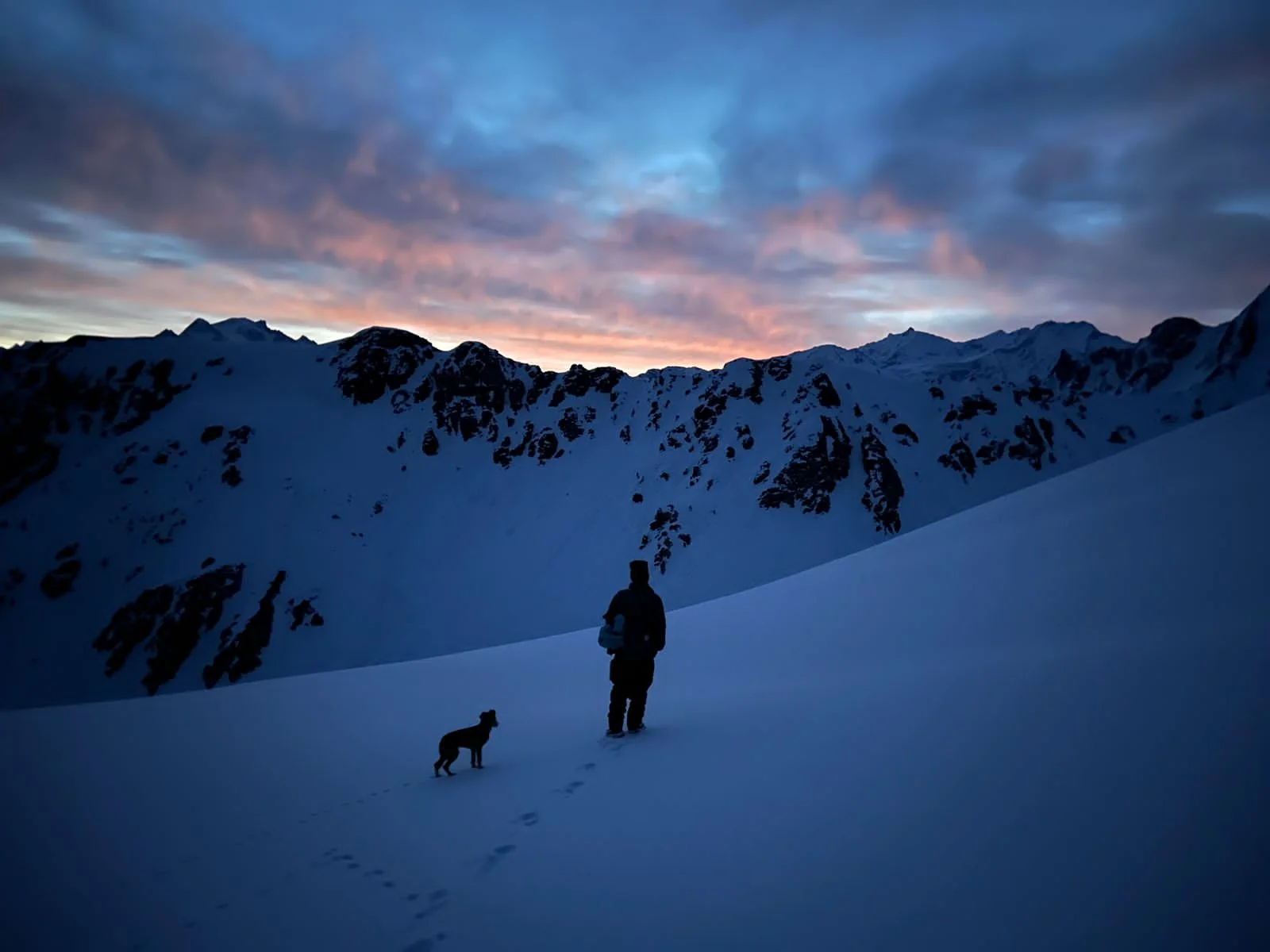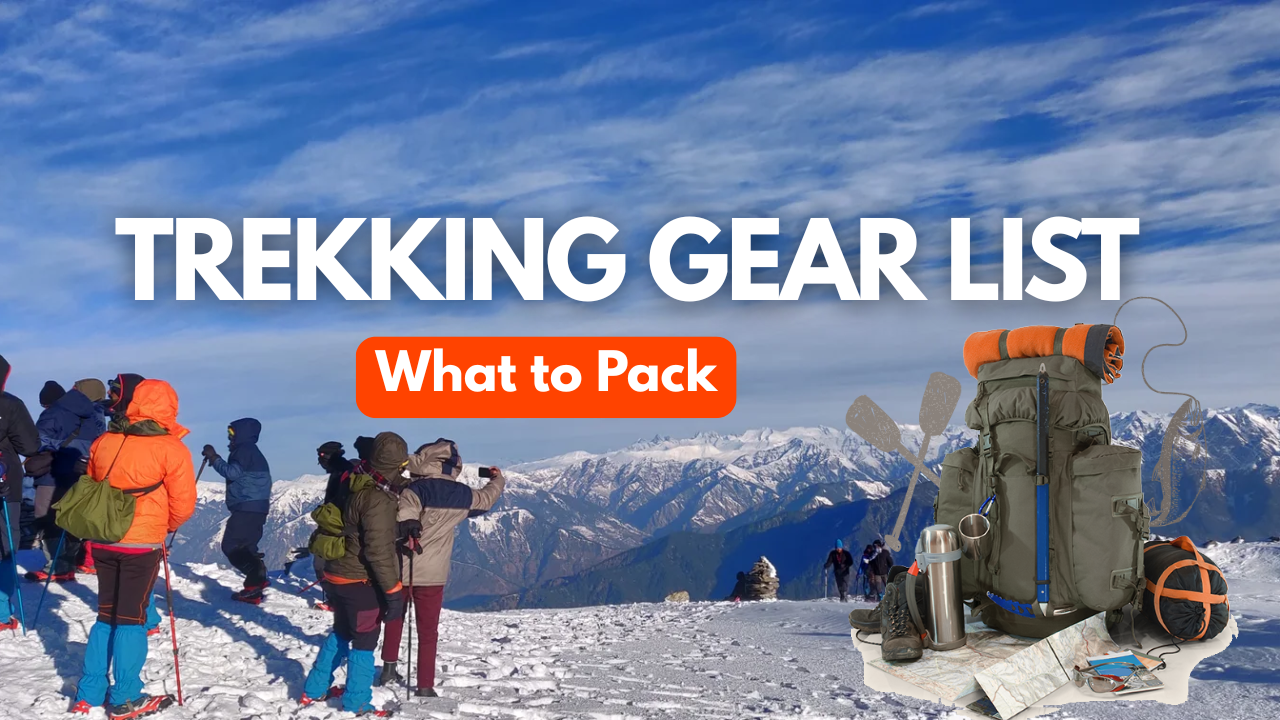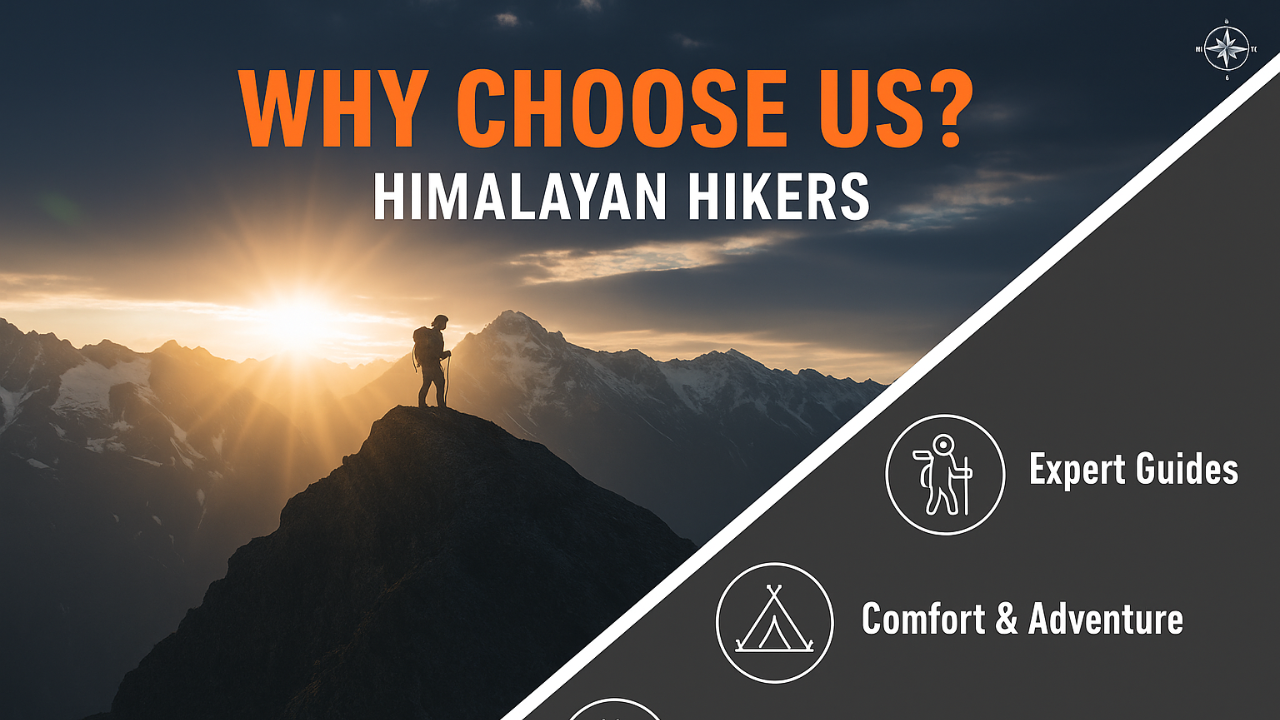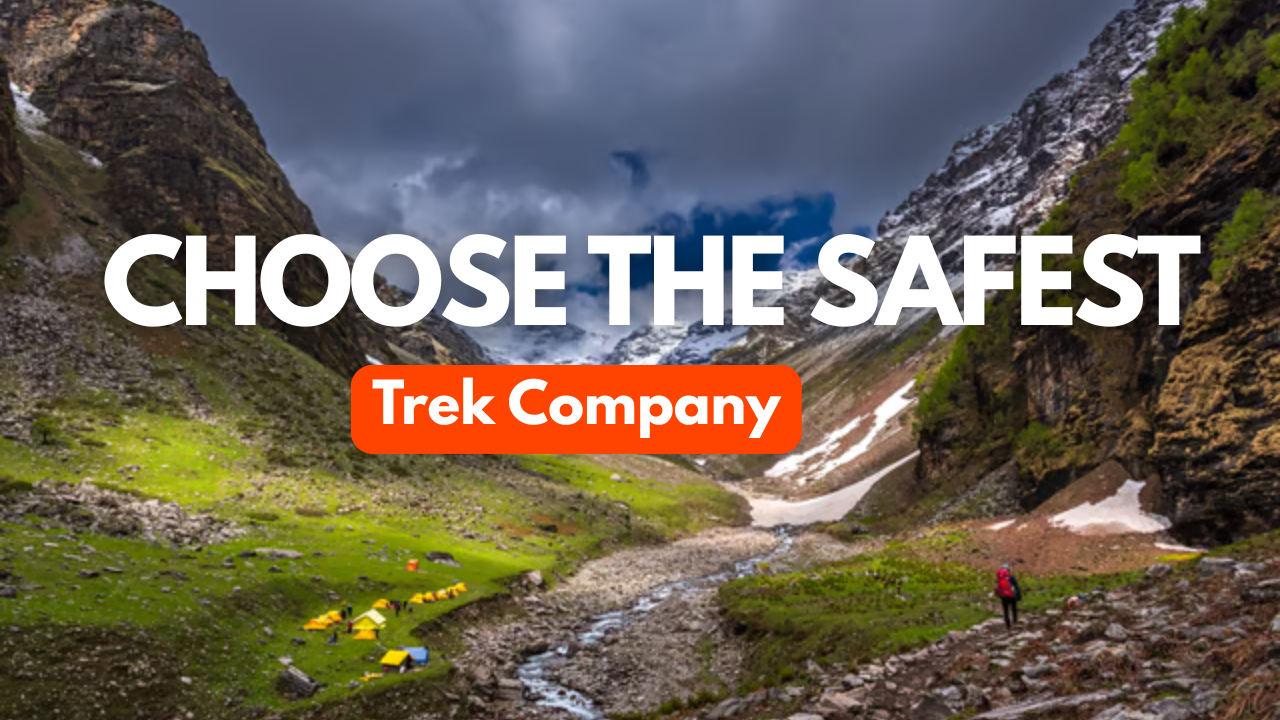The Sar Pass trek begins for Kasol, Kullu Valley which takes you through timeless Himalayan villages like Grahan, where life moves to the rhythm of wind and woodsmoke. The Sar Pass is not about reaching the highest point, it’s about the journey you make with your fellow trekker and nature that brings you closer to your better self. The trail is adorned with numerous scenic moments, whether it’s panoramic scenes of mountains or lavish grasslands. Every step here reveals a new side of Himalayan beauty.
Every step draws you deeper into a landscape that feels untouched by time and closer to parts of yourself that modern life tends to silence. Sar Pass isn’t just a trek. It’s a conversation with nature, and maybe, just maybe, with the version of yourself you’ve been too busy to meet.
Why Sar Pass Trek is Special ?
1. Alpine Beauty & Meadows
The trail is dotted with expansive alpine meadows filled with colorful
wildflowers during spring and summer. These open fields provide stunning photo
opportunities and breathtaking views of the surrounding Parvati Valley peaks.
Every step on the meadow feels like a journey deeper into Himalayan paradise.
2. Forest Trails Through Pine & Oak
The trek begins with gentle paths through dense pine, oak, and deodar
forests. The cool mountain breeze, chirping birds, and earthy forest scents
create a refreshing and immersive trekking experience. The forested trail is
beginner-friendly yet adventurous, offering the perfect mix of safety and
excitement.
3. Crystal-Clear Rivers & Waterfalls
Several streams and cascading waterfalls along the way provide natural rest
stops. The sound of flowing water, combined with the Himalayan air, rejuvenates
both the body and mind. Trekkers often pause to drink fresh mountain water and
enjoy the scenery.
4. Snow-Capped Peaks
As you ascend, the landscape transforms into snow-covered valleys and
peaks. The final stretch to Sar Pass is often surrounded by pristine snow,
offering a taste of high-altitude trekking without extreme technical
difficulty. The panoramic views of surrounding mountains like Indrasan, Deo
Tibba, and Parvati Valley peaks make the effort truly rewarding.
5. Adventure with Safety
While the Sar Pass Trek is moderately challenging, it is suitable for
beginners with good fitness levels. The trail is clearly marked, and with the
guidance of experienced trekking staff, beginners can enjoy the adventure
without fear. Trekking poles are recommended for added stability, especially on
snowy or slippery sections.
6. A Soul-Refreshing Himalayan Experience
Beyond the physical challenge, Sar Pass Trek offers a mental and emotional
retreat. Surrounded by towering peaks, untouched nature, and peaceful
campsites, trekkers feel a profound connection with the mountains. Campfire
nights under starlit skies, sunrise over snow-covered peaks, and serene meadows
make this trek an experience of a lifetime.
6 Best Things About the Sar Pass Trek
1. Expansive Alpine Meadows
The Sar Pass Trek takes you through sprawling alpine
meadows in the heart of Parvati Valley, Himachal Pradesh. These lush
green meadows, dotted with vibrant seasonal wildflowers, create picture-perfect
spots for rest, photography, and enjoying the panoramic views
of snow-capped Himalayan peaks. Trekking through these open spaces offers
an immersive connection with nature, making it a highlight of
this beginner-friendly Himalayan adventure.
2. Dense Pine, Oak, and Deodar Forests
One of the most refreshing aspects of the Sar Pass Trek is the
walk through dense Himalayan forests. Towering pines, deodars, and oak
trees create a serene canopy, providing shade, fresh air, and the soothing
sound of rustling leaves. This forested trail not only enhances the scenic
beauty but also makes the trek safe and comfortable for beginners,
offering a peaceful escape into nature.
3. Crystal-Clear Rivers and Waterfalls
Along the trail, trekkers encounter pristine rivers, glacial streams,
and cascading waterfalls, adding to the natural charm of the Sar Pass
Trek. These water bodies are perfect for refreshing breaks, capturing stunning
photographs, and connecting with the Himalayan wilderness. The sound of flowing
water combined with the mountain backdrop enhances the sense of adventure and
tranquility.
4. Snow-Capped Peaks and Sar Pass Summit
The ultimate highlight of the Sar Pass Trek is reaching
the Sar Pass summit at 4,200 meters. From here, you get panoramic views of
majestic peaks like Indrasan, Deo Tibba, and the surrounding snow-covered
valleys. The gentle snowfields leading to the pass offer an exciting challenge
while remaining accessible for first-time trekkers, making this one of the
most rewarding experiences in Himachal Pradesh trekking.
5. Cozy Campsites and Starry Nights
The trek includes well-set campsites amidst nature, perfect for unwinding after a day of hiking. Evenings here are magical, with campfires, warm meals, and starlit skies over the Himalayas. Trekkers can bond with fellow adventurers while soaking in the peaceful Himalayan environment, making the Sar Pass Trek a memorable mix of adventure and relaxation.
6. Beginner-Friendly Himalayan Adventure
Despite reaching high altitudes, the Sar Pass Trek is designed
for beginners and first-time trekkers. The trail is gradual, well-marked, and
non-technical, ensuring a safe and enjoyable experience. Professional guides
assist throughout the trek, making it an ideal Himalayan
adventure for anyone looking to explore the mountains without extreme
physical strain.
Why Choose Himalayan Hikers for the Sar Pass Trek?
Choosing Himalayan Hikers for the Sar Pass Trek ensures a safe, organized, and memorable Himalayan adventure. Our highly trained, certified, and experienced trek leaders are passionate about mountain exploration and committed to offering the best trekking experience in Himachal Pradesh. We focus on sustainable adventure tourism, work closely with local communities, and ensure responsible trekking practices that protect the fragile Himalayan ecosystem. With Himalayan Hikers, trekkers enjoy a safe, professionally managed, and deeply enriching Sar Pass Trek experience.
What Makes the Sar Pass Trek Special?
1. Stunning Himalayan Landscapes
The Sar Pass Trek route takes you through lush pine, oak, and deodar forests, scenic meadows, charming mountain villages, and sparkling natural streams. This trail is a paradise for nature lovers, photographers, and trekkers who want to experience the unspoiled beauty of the Parvati Valley.
2. Majestic Sar Pass Summit (13,800 ft / 4,200 m)
Reaching the Sar Pass summit is the highlight of the trek. From
the top, trekkers witness panoramic views of the Parvati Valley, Tosh
Valley, and the surrounding snow-covered Himalayan peaks. These breathtaking
vistas make it one of the best high-altitude treks in Himachal Pradesh.
3. Perfect Medium-Difficulty Himalayan Trek
Known for its balanced difficulty level, the Sar Pass
Trek features moderate climbs, narrow ridges, snow traverses, and fun
descents. It is an excellent choice for both first-time high-altitude
trekkers and experienced hikers seeking a rewarding challenge.
4. Beautiful and Serene Campsites
Campsites like Grahan, Min Thach, Nagaru, and Biskeri Thach offer
some of the most picturesque camping locations in the Himalayas. Surrounded by
forests, valleys, and snowfields, these camps provide a peaceful and
unforgettable Himalayan camping experience.
5. Rich Himachali Culture and Local Interaction
The trek passes through traditional Himachali villages, giving trekkers the
opportunity to experience local culture, customs, and authentic mountain
cuisine. This cultural immersion adds depth and meaning to the overall trek
experience.
6. Exciting Adventure Activities
Depending on weather and trail conditions, trekkers may also
enjoy rappelling, rock climbing, snow slides, and other adventure
activities, making Sar Pass one of the most fun-filled adventure treks in
the Himalayas.
7. Visit to Manikaran Hot Springs (Optional)
After completing the trek, many trekkers visit the sacred Manikaran
hot springs, known for their natural healing properties. This relaxing
experience is the perfect way to unwind after days of trekking.
What Makes the Sar Pass Trek Unique?
- One of the few Himalayan treks offering diverse landscapes: forests, meadows, snowfields, and high-altitude passes
- Exceptional views of glaciers, deep valleys, and towering snow-covered peaks
- Warm hospitality and rich traditions of local Himachali communities
- A perfect blend of adventure, scenic beauty, cultural experience, and Himalayan wilderness
The Sar Pass Trek is a must-do Himalayan adventure—ideal for nature lovers, photographers, trekkers, and anyone seeking an unforgettable journey through the stunning landscapes of Himachal Pradesh.
Sar Pass Trek Guide
DAY 1 – Report at Kasol Base camp before 9:30 AM. – All Group meet together- and Himalayan
Hikers team take 01 Hours for Briefing for the Sar Pass Trek | Same Day Start Trek from Kasol to Grahan village| Distance: 07 km | Trek Time: 5/6 hours | Altitude 7,709 ft | Overnight Stay at Home Grahan
DAY 2- Trek from Grahan village to Min Thach Camp
Distance: 07.5 km | Trek Time: 6/7 hours | Altitude 11,154 ft | Overnight Stay Camp at–Twin/ Three Sharing
DAY 3- Trek from Min Thach Camp to Nagaru Base of Sar Pass
Distance: 05 km | Trek Time: 5/6 hours | Altitude 12,400 ft | Overnight Stay Camp at–Twin/ Three Sharing
DAY 4- Trek from Nagaru Base to Biskeri Thach via SAR Pass Summit
Altitude 13,600 ft | Distance: 12 km | Trek Time: 7/8 hours | Cross to Sar Pass to Biskeri Camp Altitude 11,100 ft | Overnight Stay Camp at–Twin/ Three Sharing
DAY 5- Trek from Biskeri Thach to Pulga Road
Distance: 06 km | | Trek Time: 4/5 hours | Same Day Drive to Kasol Market -Distance: 15 km | Trek Time: 1 hours
Himalayan Hikers Drop Kasol around 1 to 2 PM END OUR SERVICE HERE
Day 1: Reach Our Base Camp Kasol 8:30 am to 9:00 am Then trek to Grahan Village
Route:
- Starting Point: Kasol Bus Stand Base Camp of H.H
- Destination: Grahan Village
- Distance: Approximately 07 kilometers
- Time Required: Around 4-6 hours, depending on your pace and breaks
- Difficulty Level: Moderate
Trek Details:
- Pickup from Kasol Bus Stand Himalayan Hikers Camp:
- Kasol is well-connected by road, and you can easily reach there by bus or taxi from nearby towns like Bhuntar or Manali. Once you arrive at Kasol Bus Stand, you can start your trek.
- Trekking to Grahan Village:
- The trail starts from Kasol and leads towards Grahan Village. You’ll need to cross the Parvati River and then start ascending through dense forests.
- The initial part of the trek involves a gradual ascent through the forest, with occasional steep sections.
- The trail is well-marked, but it’s recommended to have a local guide or a map with you.
- As you ascend, you’ll pass through lush greenery, pine forests, and possibly encounter some streams.
- After a few hours of trekking, you’ll reach the beautiful Grahan Village, situated at an altitude of around 7,700 feet above sea level.
- Grahan Village is a quaint Himalayan hamlet, offering stunning views of the surrounding peaks and valleys.
- Difficulty Level:
- The trek from Kasol to Grahan Village is considered moderate in difficulty.
- While the trail is well-defined, there are some steep sections, especially during the ascent.
- Proper trekking gear, including sturdy hiking shoes, water, snacks, and a rain jacket (depending on the weather), is recommended.
- It’s also essential to pace yourself and take regular breaks, especially if you’re not used to hiking at higher altitudes.
- Important Tips:
- Start your trek early in the morning to make the most of daylight hours and avoid trekking in the dark.
- Carry an adequate amount of water and snacks to keep yourself hydrated and energized throughout the trek.
- Respect the local culture and environment. Avoid littering and follow the principles of Leave No Trace.
- Check the weather forecast before starting your trek and be prepared for changes in weather conditions.
Day 2 : Trek from Grahan to Mini Thatch
Route:
- Starting Point: Grahan Village
- Destination: Mini Thatch
- Distance: Approximately 7-8 kilometers
- Time Required: Around 4-5 hours, depending on your pace and breaks
- Difficulty Level: Moderate
Trek Details:
- Starting from Grahan Village:
- From Grahan Village, head towards the trail leading to Mini Thatch. You’ll find signposts or locals who can guide you in the right direction.
- The trail initially ascends through dense forests, similar to the previous segment from Kasol to Grahan.
- You’ll pass through scenic landscapes, lush greenery, and possibly encounter some streams along the way.
- Ascend to Mini Thatch:
- The trek involves a significant ascent as you make your way towards Mini Thatch.
- The trail may become steeper and more challenging compared to the previous segment. Be prepared for some strenuous sections.
- As you climb higher, you’ll be rewarded with breathtaking views of the surrounding valleys and snow-capped peaks.
- Mini Thatch is a beautiful meadow nestled amidst the mountains, offering a tranquil setting for camping or resting.
- Difficulty Level:
- The trek from Grahan to Mini Thatch is considered moderate to difficult, primarily due to the steep ascent.
- You’ll need to have a good level of fitness and stamina to tackle the uphill sections.
- Proper trekking gear, including sturdy hiking shoes, trekking poles (if required), water, snacks, and warm clothing, is essential.
- Take regular breaks to catch your breath and enjoy the scenery along the way.
- Important Tips:
- Start early in the morning to make the most of daylight hours and avoid trekking in the dark.
- Carry sufficient water and snacks to keep yourself hydrated and energized during the trek.
- Be mindful of your surroundings and follow the trail markers or ask locals for directions if needed.
- Take precautions against altitude sickness, especially if you’re ascending to higher elevations.
- Respect the local environment and leave no trace of your visit.
Trekking from Grahan Village to Mini Thatch offers a challenging yet rewarding experience amidst the natural beauty of the Himalayas. Enjoy the journey and embrace the serenity of the mountai
Day 3 : Trek from Mini Thatch to Naguru
Trekking from Mini Thatch to Nagaru is a segment that takes you further into the scenic landscapes of the Parvati Valley, eventually leading you to the base camp for the Sar Pass trek. Here’s a guide for this part of your journey:
Route:
- Starting Point: Mini Thatch
- Destination: Nagaru
- Distance: Approximately 5-6 kilometers
- Time Required: Around 3-4 hours, depending on your pace and breaks
- Difficulty Level: Moderate to Difficult
Trek Details:
- Beginning from Mini Thatch:
- Depart from Mini Thatch and follow the trail towards Nagaru. The route may be marked with signs or cairns, but it’s advisable to have a local guide or a map to navigate effectively.
- The initial part of the trek involves ascending further through alpine meadows and possibly rocky terrain.
- You’ll continue to enjoy panoramic views of the surrounding mountains and valleys as you gain altitude.
- Ascent to Nagaru:
- The trail gradually becomes steeper as you ascend towards Nagaru.
- You may encounter some challenging sections with rocky paths and uneven terrain.
- It’s essential to pace yourself and take regular breaks, especially considering the altitude gain.
- Keep an eye out for any trail markers or signs to ensure you’re on the right path.
- Views and Landscape:
- Along the way, you’ll be treated to stunning views of the Parvati Valley below and the towering peaks surrounding you.
- Nagaru itself is situated at a higher altitude, offering breathtaking vistas of the Himalayan landscape.
- Difficulty Level:
- The trek from Mini Thatch to Nagaru is considered moderate to difficult, primarily due to the steep ascent and potentially challenging terrain.
- Altitude gain can also be a factor, so it’s essential to acclimatize properly and be prepared for the effects of high altitude.
- Ensure you have the necessary trekking gear, including sturdy hiking shoes, warm clothing, water, snacks, and a first aid kit.
- Important Tips:
- Start early in the day to make the most of daylight hours and avoid trekking in the dark, especially considering the terrain’s difficulty.
- Stay hydrated and fuel yourself with snacks to maintain energy levels throughout the trek.
- Keep an eye on weather conditions, as they can change rapidly in mountainous regions.
- Follow Leave No Trace principles and respect the environment and local communities.
Day 4 : Trek from Naguru to SAR Pass to Biskeri Thatch
Trekking from Nagaru to Sar Pass and then descending to Biskeri Thatch is one of the most exhilarating segments of the Sar Pass trek, offering breathtaking views and a sense of accomplishment as you traverse high-altitude landscapes. Here’s a guide for this challenging yet rewarding trek:
Route:
- Starting Point: Nagaru
- Destination: Biskeri Thatch via Sar Pass
- Distance: Approximately 12-13 kilometers
- Time Required: Around 8-10 hours, depending on your pace and breaks
- Difficulty Level: Difficult
Trek Details:
- Setting out from Nagaru:
- Begin your trek from Nagaru, situated at a considerable altitude. Ensure you’re properly acclimatized before embarking on this challenging segment.
- The initial part of the trek involves ascending towards Sar Pass. The trail is likely to be steep and rocky, requiring careful footing and endurance.
- Ascending to Sar Pass:
- As you ascend towards Sar Pass, the trail may become progressively steeper and more challenging.
- You’ll navigate through rugged terrain, possibly encountering snowfields or icy patches, depending on the season.
- Keep an eye out for trail markers or follow the guidance of your guide to stay on track.
- Sar Pass, situated at an elevation of around 13,800 feet, offers breathtaking views of the surrounding peaks and valleys, making the ascent worth the effort.
- Crossing Sar Pass:
- Once you reach Sar Pass, take some time to rest and soak in the stunning vistas before beginning your descent towards Biskeri Thatch.
- The descent from Sar Pass to Biskeri Thatch can be equally challenging, with steep gradients and potentially slippery terrain. Use trekking poles for stability if necessary.
- Descending to Biskeri Thatch:
- The trail from Sar Pass descends through alpine meadows and forests, providing a contrast to the rugged terrain of the ascent.
- While the descent may be less physically demanding than the ascent, it requires caution to navigate safely, especially on uneven terrain.
- Biskeri Thatch, nestled amidst the mountains, offers a serene camping spot to rest and rejuvenate after the day’s trek.
- Difficulty Level:
- The trek from Nagaru to Sar Pass and then to Biskeri Thatch is considered difficult, primarily due to the steep ascent, high altitude, and potentially challenging terrain.
- Proper acclimatization, physical fitness, and trekking experience are essential prerequisites for this segment.
- Ensure you have the necessary equipment, including sturdy hiking shoes, warm clothing, trekking poles, water, snacks, and a first aid kit.
- Important Tips:
- Start early in the day to allow ample time for the trek and to avoid trekking in low visibility conditions, especially during the descent.
- Stay hydrated and nourished throughout the trek to maintain energy levels.
- Keep a close watch on weather conditions and be prepared for changes in mountain weather.
- Follow Leave No Trace principles and respect the environment and local culture during your trek.
Day 5: Trek from Biskeri Thatch to Pulga road
Trekking from Biskeri Thatch to Pulga Road offers a scenic route through the picturesque landscapes of the Parvati Valley. Here’s a guide for this segment of your trek:
Route:
- Starting Point: Biskeri Thatch
- Destination: Pulga Road
- Distance: Approximately 10 kilometers
- Time Required: Around 5/6 hours, depending on your pace and breaks
- Difficulty Level: Moderate
Trek Details:
- Departing from Biskeri Thatch:
- Begin your trek from Biskeri Thatch, situated amidst the mountains and alpine meadows.
- The trail initially descends from Biskeri Thatch, gradually leading you towards lower elevations.
- Scenic Views along the Way:
- As you descend, you’ll be treated to breathtaking views of the surrounding valleys, lush forests, and distant peaks.
- The trail winds its way through forests, meadows, and possibly small streams, offering a varied and picturesque landscape.
- Traversing through Villages:
- Along the route, you may pass through or encounter several small villages inhabited by the locals.
- These villages provide a glimpse into the local way of life and may offer opportunities to interact with the residents.
- Navigating the Trail:
- While the trail is generally well-defined, it’s advisable to have a map or GPS device to ensure you’re on the right path.
- Signposts or markers may guide you along the way, but it’s always helpful to ask locals for directions if needed.
- Trekking Level:
- The trek from Biskeri Thatch to Pulga Road is considered moderate in difficulty.
- While the overall terrain may involve some descents and ascents, it’s generally less challenging compared to higher altitude treks.
- However, be prepared for uneven terrain, rocky sections, and possibly some steep gradients, particularly as you descend towards Pulga Road.
- Important Tips:
- Start your trek early in the day to make the most of daylight hours and avoid trekking in the dark.
- Carry sufficient water, snacks, and any necessary supplies for the trek.
- Wear sturdy hiking shoes and comfortable clothing suitable for trekking.
- Respect the environment and local communities along the way, and adhere to Leave No Trace principles.
- Check the weather forecast before setting out and be prepared for changes in weather conditions.
- The route from Pulga to Kasol involves driving back along the road you trekked on or taking any alternate routes available. The primary road network connects these two destinations.
- Distance:
- The distance between Pulga and Kasol by road is approximately 15-20 kilometers, depending on the specific route you take.
- Road Conditions:
- The road conditions can vary, but in general, the roads in this region are narrow and winding, often with steep inclines and declines.
- Some sections of the road may be rough or unpaved, especially in more remote areas.
- Driving Time:
- The driving time from Pulga to Kasol typically ranges from 30 minutes to an hour, depending on traffic, road conditions, and the specific route taken.
- Scenic Views:
- The drive from Pulga to Kasol offers stunning views of the surrounding mountains, valleys, and forests. Be sure to take some breaks along the way to admire the scenery and take photographs.
The Sar Pass Trek in Himachal Pradesh is categorized as a Moderate difficulty Himalayan trek, making it one of the top choices for beginners entering high-altitude trekking and for intermediate trekkers looking for a challenging yet achievable adventure. With its diverse terrain, snow-covered trails, high-altitude campsites, and stunning summit views, this trek offers the perfect balance of excitement and safety when done with proper preparation.
1. Terrain Difficulty
The trail to Sar Pass features a mix of landscapes that gradually become more challenging as you gain altitude. Trekkers will experience:
-
Easy and scenic forest trails in the beginning
-
Steep ascents from Min Thach to Nagaru
-
Narrow ridges and icy sections at higher altitudes
-
A snow-covered climb during the Sar Pass summit push
-
A long, thrilling descent through snowfields
This combination of terrain makes Sar Pass one of the most rewarding moderate treks in the Himalayas.
2. Altitude Challenges
The trek reaches a maximum altitude of 13,800 ft (4,200 m) . As you climb higher, the oxygen level decreases, and temperatures drop significantly. While the altitude is manageable for most trekkers, proper acclimatization and hydration are essential to avoid altitude-related issues.
3. Daily Trekking Distance
Trekkers typically cover 6–10 km per day, depending on the campsite and weather conditions. The trail includes:
-
Gradual walks through forests
-
Moderate climbs
-
A steep ascent to Nagaru (the toughest day)
-
Snow trekking on summit day
The varied pace makes the trek suitable for beginners with basic fitness.
4. Weather and Temperature
Weather plays a key role in difficulty:
-
Daytime: 8°C to 15°C
-
Nighttime: -5°C to 0°C at higher camps
-
Wind and snow on summit day can make the final climb more challenging
Wind, snowfall, and icy surfaces on summit day can increase the difficulty. Trekkers must carry thermal layers, waterproof jackets, gloves, and sturdy trekking shoes to ensure safety and comfort.
5. Fitness Requirement
Although suitable for first-time trekkers, basic fitness is important. You should be able to:
-
Walk for 4–6 hours a day
-
Handle steep climbs without exhaustion
-
Maintain stamina and breathing control
A 3–4 week fitness routine consisting of brisk walking, jogging, stair climbing, and breathing exercises is ideal for preparing for the Sar Pass Trek.
6. Technical Skills
The Sar Pass Trek does not require technical climbing skills. However, trekkers must be comfortable:
-
Walking on snow
-
Using trekking poles
-
Wearing microspikes if needed during summit day
Experienced trek leaders guide you through all tricky sections.
7. Ideal for beginners and Intermediate Trekkers
Sar Pass is often recommended as the best moderate Himalayan trek for beginners, thanks to:
-
Well-marked trails
-
Manageable altitude gain
-
Strong support from experienced guides
-
Balanced difficulty level
At the same time, the snow sections and changing landscapes make it exciting for seasoned trekkers as well.
The Sar Pass Trek is considered one of the safest and most popular treks in the Indian Himalayas, especially for beginners and intermediate trekkers. Organized by companies like Himalayan Hikers, it provides a well-guided and safe trekking experience.
Why Sar Pass Trek is Safe:
- Well-Marked Trails: The trek is well-trodden, and paths are clear, which makes it safer.
- Guided Trek: Himalayan Hikers and similar companies provide professional guides and support staff, ensuring a safe experience.
- Altitude: The maximum altitude on the Sar Pass Trek is around 13,800 feet, which is not very high in comparison to other Himalayan treks. This makes altitude sickness less of a concern.
- Good Infrastructure: The trail has established campsites and shelters along the way, with medical facilities and support teams if needed.
- Group Trekking: You’ll usually be trekking with a group, which adds a layer of safety.
Best Time to Trek: April to June 15
Yes, the April to June window is considered one of the best times for the Sar Pass Trek, with the following benefits:
- Weather: During this time, the weather is generally favorable—moderate temperatures and clear skies.
- Snow Conditions: There’s still some snow on the trail, especially near Sar Pass, but it's not overly harsh for trekkers, and you can experience beautiful snow-covered landscapes.
- Trekking Conditions: The weather is not too cold, and the trails are less likely to be closed due to heavy snowfall. The days are longer, providing more daylight hours for trekking.
- Flowering Season: From mid-April onwards, you’ll witness beautiful blooming wildflowers, adding to the charm of the trek.
Key Things to Keep in Mind:
- Physical Preparation: Even though it's a moderate trek, some sections can be challenging, especially when snow is present. It’s good to be physically prepared for a few steep climbs and occasional snow-covered patches.
- Weather Conditions: Weather can change rapidly in the mountains, so always be prepared for unexpected changes.
- Proper Gear: You’ll need good quality trekking shoes, waterproof clothing, warm clothing (especially at higher altitudes), and sun protection.
Trekking to Sar Pass between April to June offers several advantages, making it one of the most popular and ideal windows for the trek. Here's why this time frame stands out:
1. Perfect Weather Conditions
- Moderate Temperatures: During this period, the temperatures are comfortable for trekking. In lower altitudes (like Kasol), it stays pleasant, and at higher altitudes (around Sar Pass), it's cold but manageable.
- Clear Skies & Good Visibility: April to June generally offers clear skies, which means you'll have uninterrupted views of the surrounding peaks and landscapes. The air is crisp, and visibility is excellent for photography.
- Sunshine During the Day, Cool Nights: Days are warmer enough for trekking, but nights still get chilly, allowing for a good balance of temperature. The moderate daytime temperatures (around 10-20°C) make it great for long treks without overheating.
2. Snow-Capped Mountains & Scenic Beauty
- Snow on Sar Pass: By April, snow is still present on the Sar Pass, creating stunning views of snow-covered landscapes. The trek offers the right amount of snow for a Himalayan experience but isn't too intense for first-time trekkers.
- Spring Blooms: You'll also see wildflowers starting to bloom in the lower sections of the trek. This adds color and vibrance to the otherwise rocky and snowy terrain.
- Breathtaking Views: The clear skies and the remaining snow on the higher altitudes create postcard-like views. You'll be able to see peaks like Pin Parvati and Kullu Valley in their full glory.
To Sum It Up:
- April to June is the sweet spot for the Sar Pass Trek. It offers ideal weather, beautiful landscapes, and safe trekking conditions. You can experience the perfect balance of snow, spring blooms, and clear skies, while avoiding the risks posed by monsoon rains.
To reach Kasol, the base village for the Sar Pass Trek, you can follow these general directions:
By Air: The nearest airport to Kasol is Bhuntar
Airport, located approximately 31 kilometers away. You can take a flight to
Bhuntar Airport from major cities like Delhi or Chandigarh. From the airport,
you can hire a taxi or take a local bus to Kasol.
By Train: The nearest major railway station to Kasol is Pathankot
Railway Station, which is well connected to major cities in India. From
Pathankot, you can take a bus or hire a taxi to reach Kasol. Another option is
to take a train to Chandigarh Railway Station and then continue your journey to
Kasol by bus or taxi.
By Road: Kasol is well-connected by road and can be reached by bus
or taxi from various cities. Here are a few common routes:
From Delhi: You can take a bus from Delhi to Bhuntar, which is the
nearest major town to Kasol. From Bhuntar, you can take a local bus or hire a
taxi to reach Kasol, which is approximately 30 kilometers away.
From Chandigarh: You can take a bus or hire a taxi from Chandigarh
to Kasol. The distance between Chandigarh and Kasol is around 275 kilometers.
From Manali: If you are coming from Manali, you can take a local
bus or hire a taxi to Kasol. The distance between Manali and Kasol is
approximately 80 kilometers.
Some important points to note for Sar Pass
Please note that we don’t provide timing schedules for transportation before Manali. Subject to various conditions, the scheduled timings and availability of particular rides may differ.We recommend that trekkers reach out to our teams with any queries.You can drop an email or call us for an initial guided session.Our teams will be collecting trekkers at fixed points of airports, railway stations, and bus stands.It is recommended that unless any delay arrives, trekkers are advised to reach the destinations at least 2 hours prior.
Phone Connectivity and ATM Transactions
1) Because connectivity along the route is unpredictable, we
urge people to do all of their work ahead of time.
2) Trekkers will be provided with walkie-talkies beforehand in case of
emergency.
3) The last ATM transactions available will be at Kasol but we recommend
travelers to collect cash beforehand or while in Manali as ATM availability at
other places might not dispense cash at times.
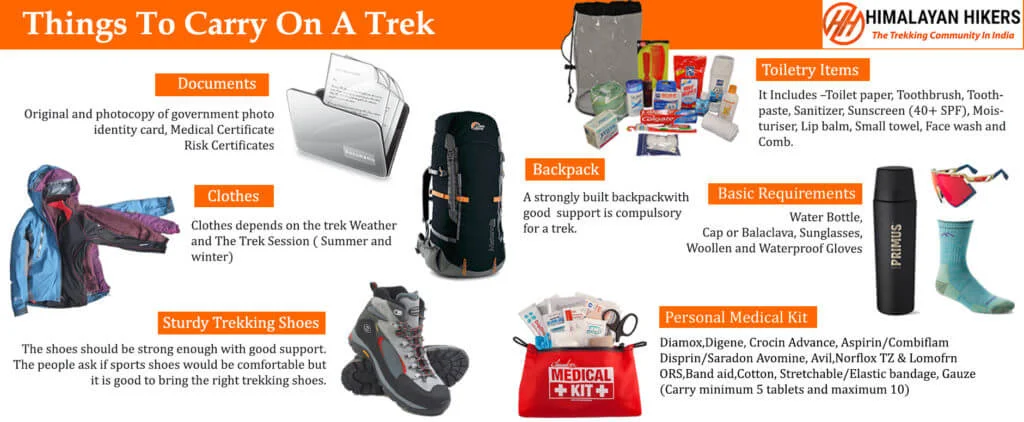
Mandatory Documents
Original and photocopy of government photo identity card- (Aadhar Card, Driving License, Voters ID, etc,)
Passport and Visa important to foreigners
Medical Certificate (First part should be filled by the Doctor and Second part by the Trekker)
Declaration Certificates
Note: – Many trekkers commit the same mistake of carrying unnecessary items on a trek which only makes the backpack heavy. It is important to know the right items to carry. It differs from season to season if you are trekking in summers then carry less layers of warm clothing and if you are trekking in winters carry enough layers to protect yourself against chilly cold.
Necessary Items for trekkers
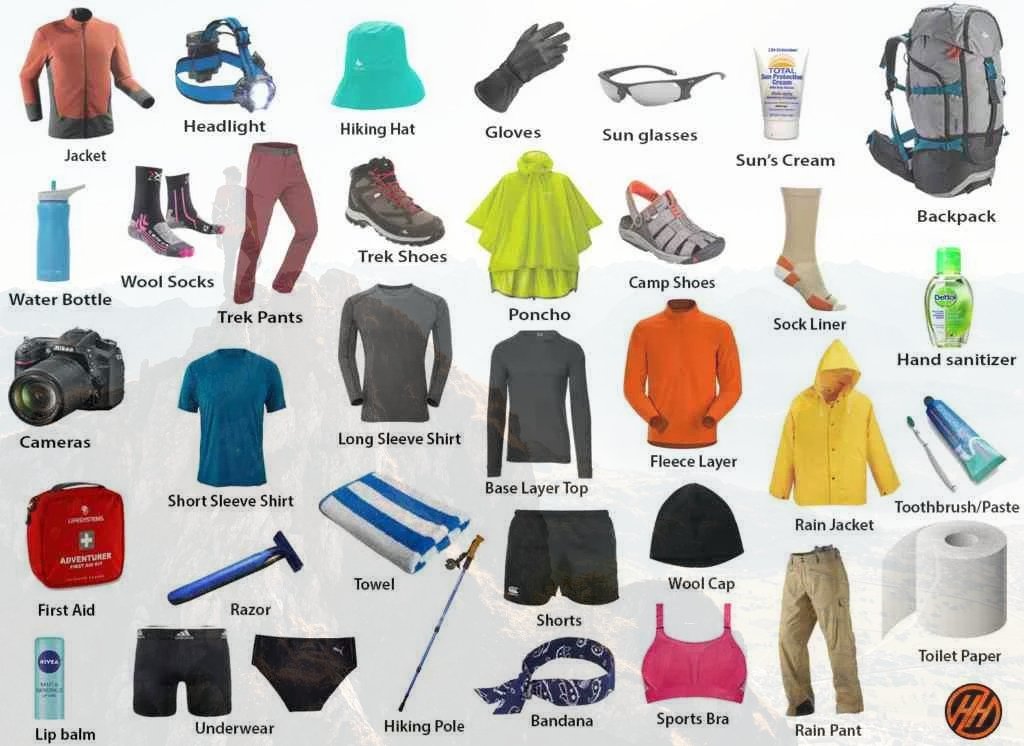
Basic Trekking Gears

The Clothes You Should Bring On Satopanth Expedition
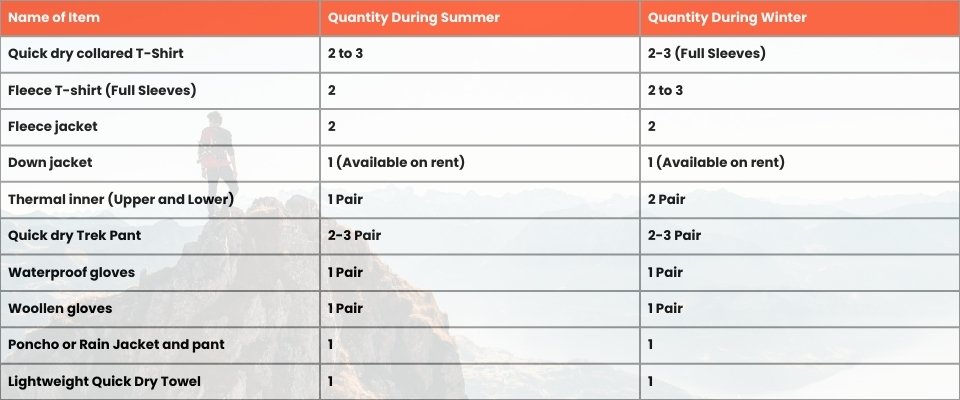
Head Gears

Foot Gears

Personal Care Essentials

Carry a Personal Medical Kit
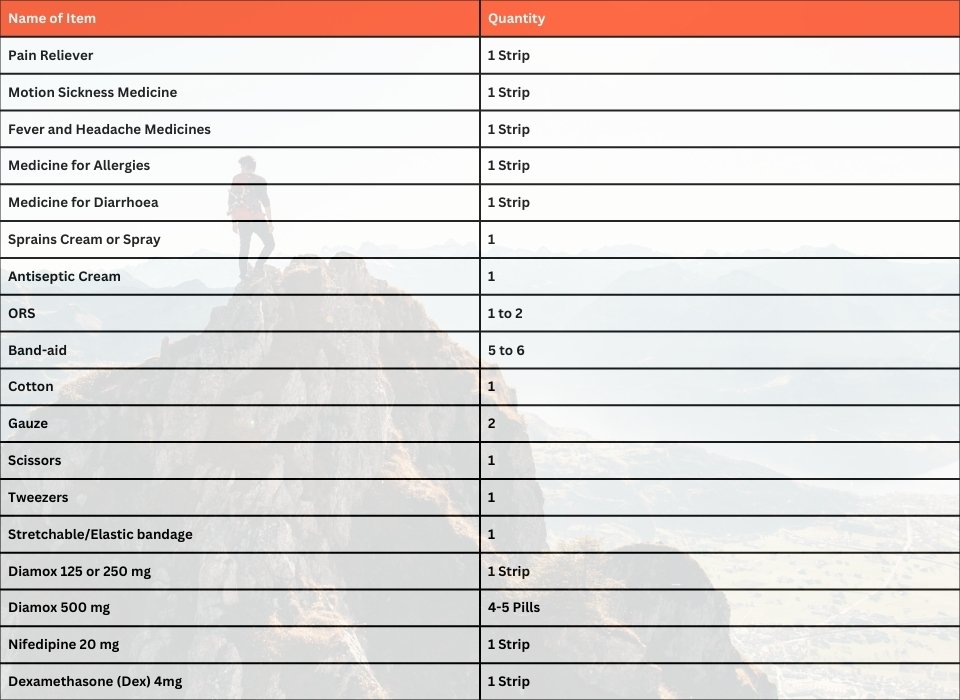
Are you Looking for Trekking Equipment on Rent?
If any trekker requires trekking equipment on rent, Himalayan Hikers offers the best-quality gear available for rental. Many individuals are in need of such equipment, and renting provides a cost-effective solution, allowing them to access high-quality gear at an affordable price without the need for a significant investment for short-term use.

Trek Equipment You can book directly on first day at the Base Camp.
Note:-
Please take all medicines only when prescribed by the doctor. In case you face any problem during your trek,
discuss and take advice from the Professional guide.
The Trek is one of the most popular treks in Uttarakhand, Himachal,Kashmir,Laddakh,Sikkim,Nepal, requiring both physical preparation and mental readiness. Although it is categorized as a moderate trek, reaches an elevation of over 12,720 feet and traverses remote Himalayan terrain, which can be physically and mentally challenging. Here's how you can prepare yourself for a safe and successful accomplishment of the Trek:
Physical Fitness
Building a good fitness base is essential for every trekker. The Trek itinerary involves 5 to 6 hours of walking every day. Though the trails are well-marked, they are often bumpy and include steep uphill sections, which may affect your stamina. You can overcome your physical limitation with a 6-week training program that you can begin about 2 months before your Trek. Your 6-week fitness routine should include

Pro Tip: If you have time, you can skip the Sunday training and go for a long-distance walk or mini day-hike (7–10 km) with a loaded backpack to simulate real trekking conditions. A short 1-day hike around your city/town can help a lot.
Mental Preparation
Physical strength is only half the journey, the other half is mental resilience. The trail takes you through remote clearings, steep climbs, cold starry nights, and no mobile connectivity. Be prepared to:
(I) -
Detach from the digital world.
(II) -
Embrace basic mountain living (camping, toilet tents, limited electricity).
(III) -
Push through moments of fatigue, weather discomfort, or altitude effects.
Himalayan Hikers is a reputable trekking company that places a high priority on safety. Here are some of the safety measures they take to ensure the safety of their clients during the Trek:
Experienced Guides: Himalayan Hikers hires experienced and certified guides who are well-versed in the terrain, weather conditions, and local culture. These guides have first-hand knowledge of the routes and are equipped to handle any emergency situations that may arise.
Proper Gear: The company provides all the necessary gear and equipment to their clients to ensure comfort and safety during the trek.
Hygiene and Sanitation: Himalayan Hikers places great emphasis on hygiene and sanitation during the Trek. They provide clean drinking water, hand sanitizers, and toilet tents to ensure that their clients are healthy and comfortable.
Emergency Services: The company has a well-defined protocol for handling emergency situations. They have a team of trained medical professionals who are available 24/7 and can be quickly mobilized in case of an emergency.
Acclimatization: Himalayan Hikers follows a gradual acclimatization process during treks to ensure that their clients adjust to the high altitude gradually. They also monitor the health of their clients regularly and provide necessary medical attention if required.
Overall, Himalayan Hikers places a great emphasis on safety and takes all necessary measures to ensure the safety and well-being of their clients during treks.
Trek Inclusions
| Category | Details |
|---|---|
| Transport | Last day transport from Pulga road to kasol |
| Permits & Entry | Forest Permit and Entrance Fees |
| Accommodation | Homestay, Tented Accommodation on Twin / tripple Sharing |
| Meals | Breakfast, Lunch, Tea, Coffee, Snacks, Soup, Dinner (All meals included) |
| Camping Gear | High-Quality Dome Tents, Sleeping Bags, Mattress, Liner |
| Sanitation Setup | Separate Toilet Tents (Ladies & Gents), Dining Tent, Dining Table, Camping Chair |
| Support Staff | Kitchen Team, Trek Helpers |
| Communication Tools | Radio Walkie-Talkie |
| Trek Guides | Experienced Trek Leader & Technical Guide |
| Safety Equipment | Medical Kit, Oxygen Cylinders, Pulse Oximeter |
| Trekking Equipment | Crampons, Gaiters, Ice ax |
Trek Exclusions
| Category | Details |
|---|---|
| Meals (Not Included) | – Day 1: En route Breakfast to base camp– Day 5: En route Dinner (not included) |
| Insurance & Documents | – Personal Insurance– Medical Certificate (Mandatory) |
| Personal Essentials | – Personal Toiletry Items– Personal Medical Kit |
| Porter Service | – Porter fee: ₹800 per day (to be paid directly at Kasol base camp)– Minimum bag weight for porter: 8 kg |
| Foreign Nationals | – ₹1600 extra for trekking permit– Passport and valid Visa required |
Important Note
No important note.
The Sar Pass Trek is a beginner-friendly Himalayan trek located in the Parvati Valley of Himachal Pradesh. Known for its lush forests, alpine meadows, and snow-capped peaks, this trek offers an unforgettable adventure for first-time trekkers and experienced hikers alike. The trek culminates at the Sar Pass summit (4,200 m), providing panoramic views of the Himalayas.
The trek starts from Barshaini village, which is accessible by road from Kasol. Trekkers can reach Kasol by:
-
By Air: Bhuntar Airport (~75 km from Kasol)
-
By Train: Joginder Nagar or Chandigarh railway stations
-
By Road: Direct buses or taxis from Manali, Delhi, or Chandigarh
From Kasol, a short drive brings trekkers to Barshaini, the official starting point of the Sar Pass Trek.
The best time to trek Sar Pass is:
-
Summer (May–June): Clear skies, dry trails, and blooming wildflowers
-
Autumn (September–October): Crisp air, minimal rainfall, and spectacular views
Winter treks (December–February) are possible with snow trekking gear, while the monsoon (July–August) is less recommended due to slippery trails and landslide risks.
The Sar Pass Trek typically takes 5–7 days, including travel time from Kasol to the base village and return. Daily trekking averages 5–7 hours, depending on pace and weather conditions.
The Sar Pass Trek is classified as Easy to Moderate, making it suitable for first-time trekkers and beginners. The trail is gradual, non-technical, and passes through forests, meadows, and snowfields, offering a perfect introduction to Himalayan trekking.
Essential items for the Sar Pass Trek include:
-
Trekking shoes, warm jackets, and thermal wear
-
Gloves, woolen cap, and rain gear
-
Backpack, water bottles, trekking poles, and sunscreen
-
Snacks, personal medications, and first-aid kit
No special permit is required for the Sar Pass Trek. However, organized trekking agencies usually handle any local permissions or entry fees as part of the package.
Accommodation during the trek is usually campsites with tents or homestays in villages like Barshaini or Grahan. Tents are provided on a twin-sharing basis, along with basic camping facilities and meals.
While the Sar Pass Trek is relatively safe for beginners, trekking with a group or experienced guide is strongly recommended. Guides provide local knowledge, safety support, and logistical assistance, making the trek more secure and enjoyable.

